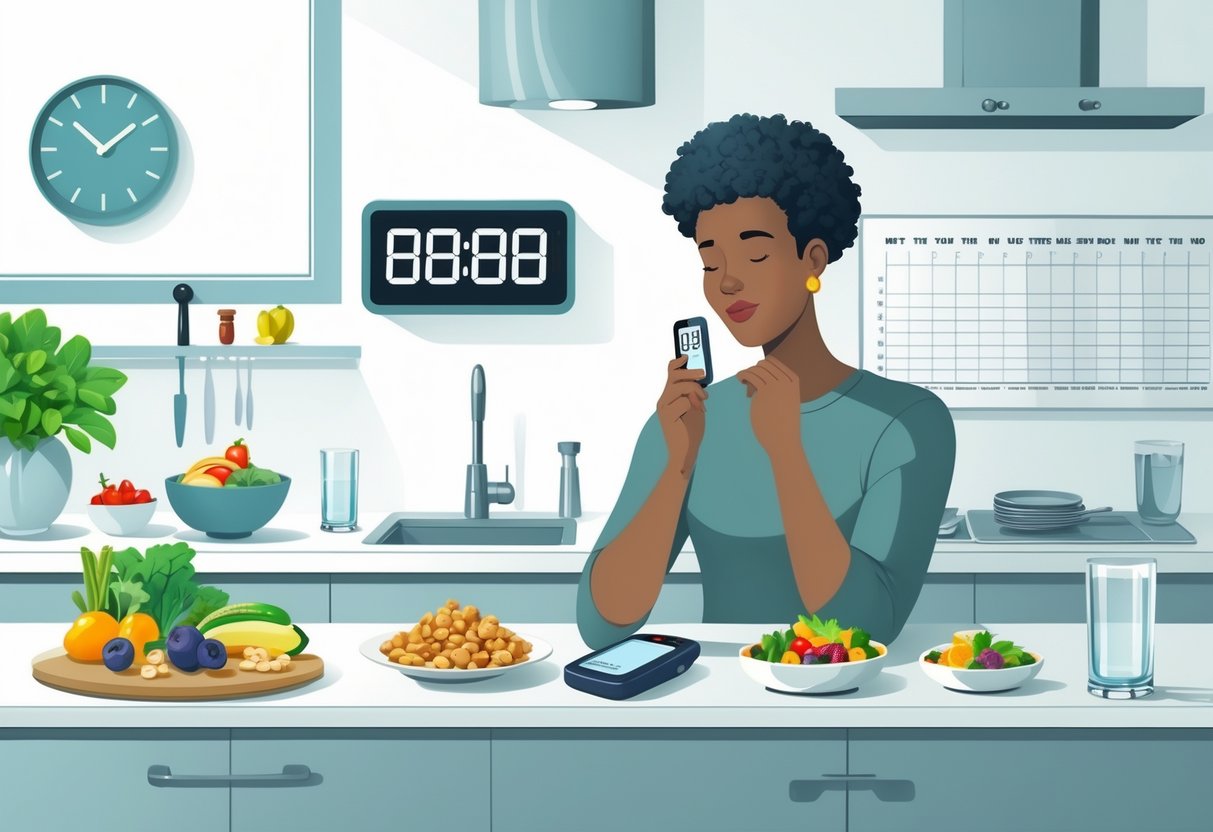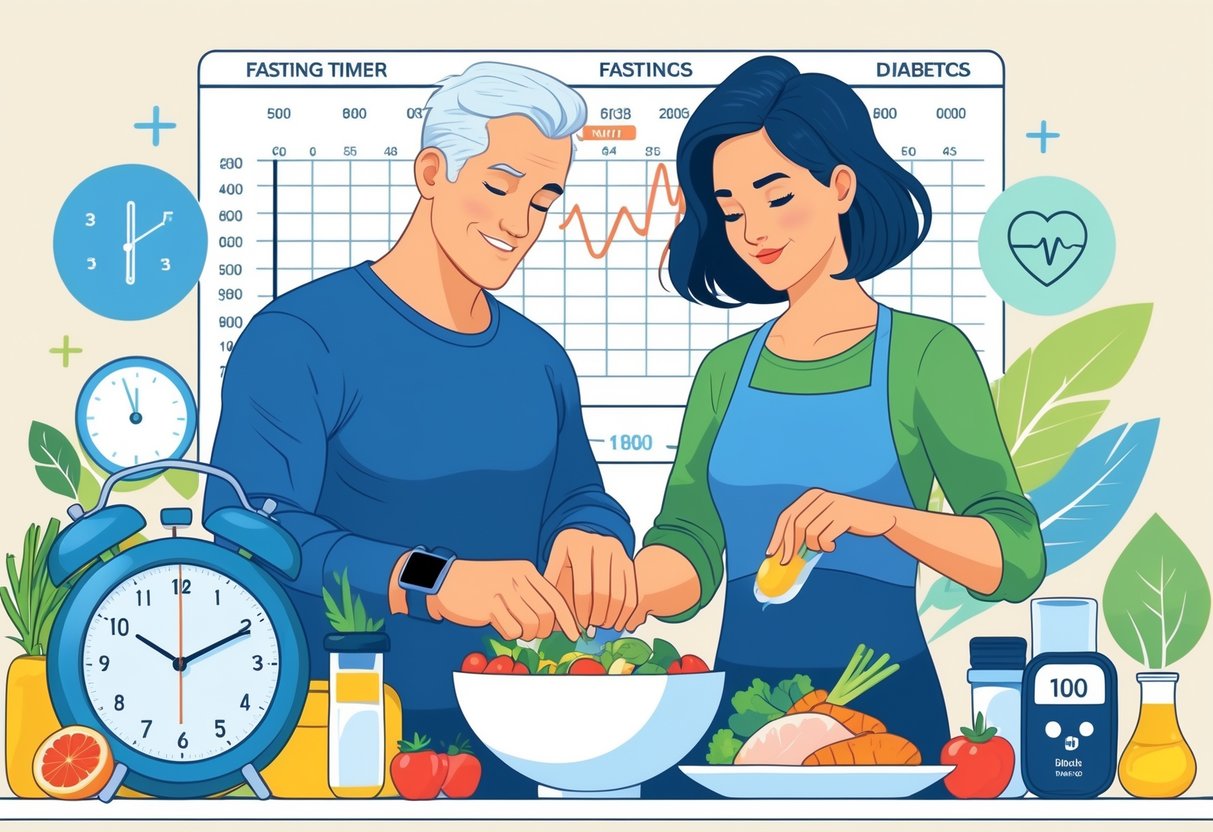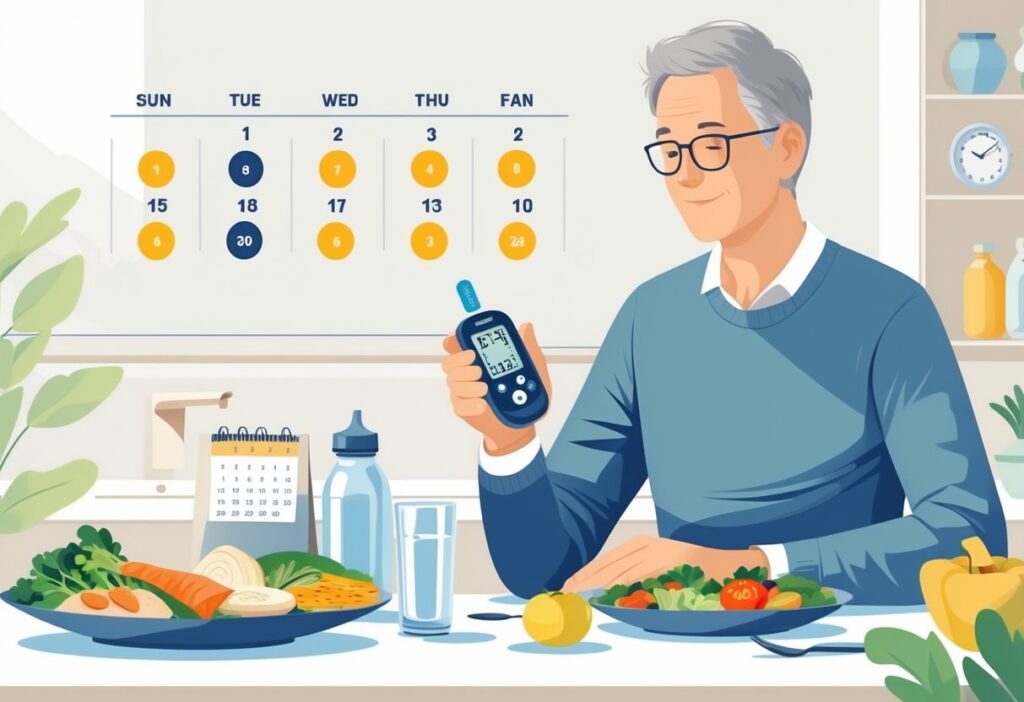Millions of people with diabetes wonder if intermittent fasting could help them manage their condition while losing weight. This eating pattern, which alternates between periods of eating and fasting, has definitely gained traction for its possible health perks.
Research suggests intermittent fasting can be safe for many people with diabetes, but only when they plan carefully and check in with their doctors.
The safety of intermittent fasting for diabetics really depends on things like diabetes type, medications, and overall health. Some small studies show intermittent fasting is safe and can help people with type 2 diabetes lose weight.
Other research even hints at better blood sugar control for some, though not everyone should jump in without thinking it through. Certain patients face higher risks and need to be extra careful before starting any fasting routine.
Key Takeaways
- Intermittent fasting can be safe for many diabetics, but only with medical supervision and good monitoring
- High-risk patients—especially those on insulin or with complications—should be extra cautious or may need to skip fasting altogether
- Adjusting medications and keeping a close eye on blood sugar are both musts for safe intermittent fasting with diabetes
Intermittent Fasting and Diabetes: What Studies Show

Recent research points out that intermittent fasting shows promise for both Type 1 and Type 2 diabetes. Some studies found that certain fasting methods can improve blood sugar and sometimes even lead to diabetes remission.
Key Research Findings on Intermittent Fasting for Diabetics
Multiple studies have shown that intermittent fasting brings measurable benefits for people with diabetes. For example, twice-per-week fasting, fasting-mimicking diets, time-restricted eating, and periodic fasting all outperformed conventional approaches.
A network analysis of fasting styles found some big improvements in common diabetes markers:
Blood Sugar Improvements:
- HbA1c levels went down significantly
- Fasting glucose dropped in more than one study
- Insulin resistance improved
One study using Chinese Medical Nutrition Therapy found that intermittent fasting may actually reverse type 2 diabetes for some people. That’s a bold claim, but the results seem promising.
The short-term benefits stand out most. Studies under three months long showed the biggest improvements in weight loss and blood sugar control.
Comparison With Traditional Calorie Restriction
Traditional diabetes management usually means calorie counting and restricting certain foods every day. Intermittent fasting flips the script—people focus on when they eat, not just what they eat.
Research suggests eating only from noon to 8 p.m. helped people manage weight and blood sugar as well as calorie counting. Many found this easier to stick with over time.
Key Differences:
| Traditional Method | Intermittent Fasting |
|---|---|
| Daily calorie counting | Eating time windows |
| Food type restrictions | No food type limits |
| Constant monitoring | Simple time rules |
People often struggle to follow traditional calorie restriction long-term. Intermittent fasting can feel more straightforward since the rules are about timing, not every single bite.
Plus, fasting seems to trigger some different metabolic changes compared to just eating less.
Time-Restricted Eating and Blood Sugar Control
Time-restricted eating means you eat only during certain hours each day. The most common version lets people eat within an 8-hour window.
Studies have found that 8-hour TRE (time-restricted eating) might help control blood glucose in people at high risk of type 2 diabetes. It seems to work no matter when you choose your window.
Common Time Windows:
- 12 p.m. to 8 p.m.
- 10 a.m. to 6 p.m.
- 8 a.m. to 4 p.m.
Consistency matters more than the exact hours. People can pick a window that fits their lives and still see results.
New research suggests intermittent fasting with low-calorie meal replacements can help people with type 2 diabetes lose weight and improve blood sugar at the same time.
Time-restricted eating looks especially helpful for cutting insulin resistance and improving how the body handles glucose in diabetic patients.
Examining the Safety of Intermittent Fasting for Diabetics

Diabetics deal with unique risks when they try intermittent fasting, like blood sugar swings and medication issues. Medical supervision is a must, and the risks differ for Type 1 and Type 2 patients.
Risks of Hypoglycemia, Hyperglycemia, and Dehydration
Hypoglycemia—low blood sugar—poses the biggest immediate danger during fasting. If someone skips meals but keeps taking insulin or glucose-lowering meds, blood sugar can crash. Dizziness, confusion, and shakiness are common warning signs.
Severe hypoglycemia can cause seizures or unconsciousness, especially with long fasting windows (think 16 hours or more).
Hyperglycemia sometimes happens when people break a fast with a big meal. Blood sugar can spike if the body can’t handle all the glucose at once.
Dehydration makes things worse. Many diabetics mistake thirst for hunger while fasting and forget to drink enough water.
Watch out for these dehydration signs:
- Dry mouth and feeling extra thirsty
- Fatigue and headaches
- Peeing less often
- Dark, concentrated urine
Diabetics lose more fluids because high blood sugar makes them urinate more. So, staying hydrated during fasting is really important for stable glucose.
Medication Adjustments and Medical Supervision
People need to tweak their diabetes meds when they start intermittent fasting. Insulin doses, in particular, have to match up with new eating schedules to avoid dangerous lows.
Medications that often need changes:
- Insulin (all kinds)
- Sulfonylureas (glyburide, glipizide)
- Meglitinides (repaglinide, nateglinide)
Doctors usually check in more often during the first weeks. Patients test blood glucose more frequently to see how their bodies react to the new routine.
Some people might even need to switch to different meds. Long-acting options tend to work better than short-acting ones while fasting.
Essential monitoring:
- Daily blood sugar checks
- Weekly weigh-ins
- Monthly HbA1c tests
- Regular kidney function labs
Never change your meds on your own. Having a doctor involved makes fasting much safer for diabetics.
Doctors should set up emergency plans before people start fasting. Diabetics need clear instructions for what to do if blood sugar drops too low during a fast.
Differences Between Type 1 and Type 2 Diabetes
Type 1 diabetics have higher risks since their bodies don’t make insulin at all. They rely on injected insulin, so managing blood sugar during fasting gets tricky and unpredictable.
Some research says intermittent fasting might help Type 1 patients, but it takes really close monitoring. These folks need to check their blood sugar more often and time their insulin just right.
Type 2 diabetics usually do better with fasting. Their bodies still make some insulin, which helps keep things steadier while fasting.
Studies show intermittent fasting works as well as calorie-counting for Type 2 patients who want to manage weight and blood sugar. Some evidence even suggests fasting could reverse Type 2 diabetes for a few people.
Key differences in management:
| Type 1 Diabetes | Type 2 Diabetes |
|---|---|
| Higher hypoglycemia risk | Lower hypoglycemia risk |
| More frequent monitoring needed | Less intensive monitoring |
| Complex insulin adjustments | Simpler medication changes |
| Requires specialized supervision | Standard medical oversight |
Type 2 patients usually see better results and need less intensive care than Type 1 patients trying intermittent fasting.
Which Diabetic Patients Should Avoid Intermittent Fasting?

Some diabetic patients face serious health risks with intermittent fasting and probably shouldn’t try it. Patients on insulin or multiple diabetes meds need to be especially careful because their risk for low blood sugar goes way up.
High-Risk Groups and Contraindications
Some groups of diabetic patients really shouldn’t try intermittent fasting at all. Pregnant women with diabetes need steady nutrition for their baby’s development, so skipping meals just isn’t safe for them.
Breastfeeding moms need more calories to make milk. Intermittent fasting is unsafe for people who are pregnant or breastfeeding because fasting can push the body to burn both fat and muscle, which isn’t ideal for mom or baby.
Elderly diabetics—especially folks over 75—usually don’t tolerate long stretches without food. Their bodies just don’t handle hunger or blood sugar swings as well as they used to.
High-risk patients include:
- Pregnant women with gestational or pre-existing diabetes
- Breastfeeding mothers with diabetes
- Elderly patients over 75 years old
- People with eating disorder history
- Patients with advanced kidney disease
If someone’s diabetes isn’t well-controlled, intermittent fasting can be dangerous. Unstable blood sugar swings make fasting risky and, honestly, not worth the gamble.
Considerations for People on Insulin or Multiple Medications
For diabetics using insulin, intermittent fasting poses the highest risk. People on insulin who restrict eating may experience dangerous low blood sugar that can sometimes lead to seizures or even passing out.
Some medications, like sulfonylureas and meglitinides, keep working even if you skip meals, which can make fasting tricky.
High-risk medications:
- Insulin (all types)
- Sulfonylureas (glyburide, glipizide)
- Meglitinides (repaglinide, nateglinide)
Anyone taking multiple diabetes meds really needs their doctor in the loop. Most of these medications depend on regular meals, so it’s not as simple as just skipping breakfast.
Research shows intermittent fasting doubles the risk for hypoglycemia in people with type 2 diabetes. That risk goes way up for people on blood sugar–lowering meds.
Doctors often need several weeks to safely adjust medications for fasting. Nobody should try intermittent fasting on their own if they’re on multiple diabetes drugs.
Potential Health Benefits Beyond Blood Sugar Control

Intermittent fasting brings a few perks for diabetics, not just for blood sugar. Studies point to improvements in body weight and heart health, and inflammation throughout the body drops, too.
Weight Loss and Metabolic Improvements
Intermittent fasting helps people with diabetes lose weight more effectively than many traditional diets. Since you only eat during certain hours, you naturally cut calories without obsessing over every bite.
Researchers have found that diabetics can lose about 5-10% of their body weight in just three months of intermittent fasting. This happens because your body switches from burning sugar to burning stored fat when you’re not eating for a while.
Metabolic benefits are real, too—insulin sensitivity improves, and the body gets better at burning fat. When people drop extra weight, they often need less medication, which is a win.
Key metabolic improvements include:
- Reduced belly fat storage
- Better fat burning capacity
- Improved hormone balance
- Enhanced cellular repair processes
These changes help keep blood pressure and cholesterol in a healthier range. Altogether, weight loss and metabolic boosts can make a lasting difference for diabetics.
Heart Health, Inflammation, and Quality of Life
Research on cardiovascular benefits shows promise for diabetics who try intermittent fasting. Heart disease risk drops when fasting is paired with good medical care.
Fasting lowers inflammation markers in the body, which means less damage to blood vessels and organs. That’s especially crucial for diabetics, who already face higher cardiovascular risks.
Many people say they feel more energetic and clear-headed during fasting periods. Sleep tends to get better after a few weeks, too. These little quality-of-life perks can help folks stick with healthier habits.
Cardiovascular improvements include:
- Lower blood pressure readings
- Improved cholesterol ratios
- Reduced arterial stiffness
- Better blood flow to organs
Less inflammation can even mean less joint pain and better digestion. Some diabetics notice fewer aches and a happier gut when they fast regularly.
Best Practices for Safe Intermittent Fasting in Diabetes
Anyone with diabetes needs to monitor blood sugar closely, plan meals, and work with their doctor before starting intermittent fasting. These steps help keep blood sugar drops at bay and make sure fasting fits with their meds.
Monitoring Blood Glucose and Recognizing Warning Signs
Checking blood sugar becomes extra important during intermittent fasting. Diabetics should test before, during, and after fasting periods to stay safe.
Key monitoring times include:
- Upon waking
- Before breaking the fast
- Two hours after eating
- Before bed
Watch out for low blood sugar signs like shaking, sweating, dizziness, confusion, or a racing heart. If blood sugar drops below 70 mg/dL, it’s time to break the fast and eat or drink something sugary—juice or glucose tablets work fast.
High blood sugar needs attention, too. If it’s above 250 mg/dL and there are ketones, fasting should stop right away.
Continuous glucose monitors can make things easier by showing blood sugar trends all day, no finger pricks needed.
Meal Planning and Nutrition During Fasting
Balanced meals during eating windows help prevent blood sugar spikes. It’s smart to focus on protein, healthy fats, and complex carbs—nothing too wild.
Recommended foods include:
- Lean proteins like chicken, fish, and beans
- Non-starchy vegetables like broccoli and spinach
- Whole grains like brown rice and quinoa
- Healthy fats from nuts, seeds, and olive oil
Breaking a fast gently is better than going big. Start with a small snack to avoid a blood sugar rollercoaster.
Time-restricted eating may help control blood glucose in people at risk for type 2 diabetes. An 8-hour eating window seems promising for managing blood sugar.
Don’t forget to drink plenty of water during fasting hours. Tea and black coffee are fine, too—just skip the sugar and cream.
Working With Healthcare Providers
Always check with your doctor before starting fasting. They might need to tweak your medications to keep blood sugar from dropping too low.
Doctors sometimes lower insulin or other diabetes meds during fasting. This helps prevent hypoglycemia when you’re eating less.
Medical professionals advise caution so intermittent fasting helps, not harms, people with diabetes.
Regular check-ins give your provider a chance to track A1C, weight, and how your meds are working.
Some folks just shouldn’t fast—people with eating disorder histories, pregnant women, or those with unstable diabetes should steer clear.
A registered dietitian can help, too. They’ll work with you to build meal plans that fit both your fasting schedule and diabetes goals.
Frequently Asked Questions
People with diabetes have a lot of questions about fasting schedules, meds, and blood sugar. Here are some of the most common concerns and tips for those thinking about intermittent fasting.
What are the potential risks of 16/8 intermittent fasting for individuals with diabetes?
The biggest risk for diabetics trying 16/8 intermittent fasting is low blood sugar during fasting. This mostly happens to people taking insulin or sulfonylureas.
Some people feel dizzy or weak during the 16-hour fast, especially if their blood sugar dips too low.
Older diabetics might lose muscle along with fat, which isn’t ideal. Fasting can trigger unhealthy patterns for anyone with a history of eating disorders, so it’s best to avoid it in those cases.
Which intermittent fasting schedule is most suitable for people with prediabetes?
Time-restricted eating works best for prediabetes—think eating within a 6- to 8-hour window.
Most people like the 12 p.m. to 8 p.m. window. That way, dinner can still be a social meal.
People with prediabetes often see better insulin resistance and improved fasting insulin with this schedule. Plus, calories usually drop by about 500 per day without much effort.
How can intermittent fasting affect blood sugar control in those with type 2 diabetes?
Intermittent fasting can improve blood sugar control for people with type 2 diabetes. Studies show A1C can drop by up to a full point within a few months.
People using continuous glucose monitors often spend more time in their target range. This happens mostly because of natural calorie reduction with time-restricted eating.
Fasting insulin and insulin resistance both tend to improve. Losing weight through fasting usually brings even better blood sugar control.
Are there specific fasting guidelines for diabetics taking metformin?
Most people on metformin can do intermittent fasting safely. Metformin doesn’t usually cause low blood sugar by itself.
It’s still best to take metformin with food to avoid an upset stomach. Try to time your doses during eating windows.
Some doctors suggest splitting the dose between meals for more even coverage.
Keep a close eye on blood sugar when starting fasting with metformin, just to be safe.
What is the recommended duration of fasting for diabetics considering intermittent fasting?
For most diabetics, a 16-hour fast with an 8-hour eating window works well. This gives benefits without too much risk for low blood sugar.
Starting with shorter fasts—like 12 hours—makes sense. You can work up to 16 hours over time.
Studies show people can maintain this pattern for a year or more, usually sticking with it most days of the week.
No need to go longer than 16 hours. The real benefits come from eating less overall, not from marathon fasts.
How should diabetics on a 16/8 intermittent fasting plan structure their meal plans?
If you’re diabetic and trying the 16/8 intermittent fasting plan, focus on balanced meals during your 8-hour eating window. Try to get some protein, healthy fats, and complex carbs on your plate each time you eat.
For that first meal after fasting, keep things moderate—starting with a huge plate can send your blood sugar soaring. It’s honestly tempting to overdo it, but your body will thank you if you take it easy.
Spacing meals out by about 3 to 4 hours seems to work best in that window. This usually means you’ll get two solid meals and maybe a little snack, if you’re hungry.
Most folks don’t need to obsess over calorie counting during these windows. Just the act of limiting your eating times usually cuts down how much you eat anyway.



Pingback: Dates & Diabetes: Glycemic Impact, Benefits, and Safe Use - Pharma Heals